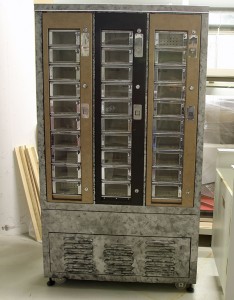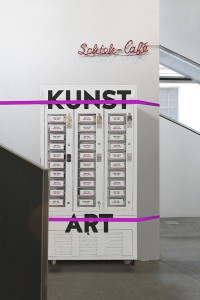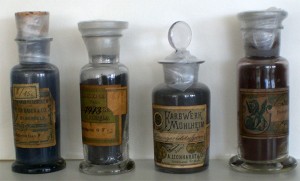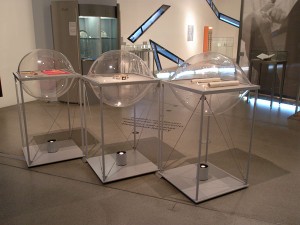
This is what the vending machine looked like originally.
© Jewish Museum Berlin, photo: Gelia Eisert
Usually a museum is a place where you can contemplate art from a safe distance. Today, with the mounting of our Art Vending Machine in our permanent exhibition, that will change: now you can put 4 euros in the coin slot, and own a piece of art from the museum!
If you’re imagining a high-tech machine that produces art, when you read the words “Art Vending Machine,” or something like a soda machine, where you can pick and choose from a selection, you’re on the wrong track. Our Art Vending Machine has a supply of small-scale artworks that were created by artists especially for it.
Since a device of this kind isn’t commercially available, I bid online for an old vending machine from the 1970s. I found one in a sports center in the Rhineland-Palatinate region of Germany and had it transported to us from there.

After its modification, the vending machine should look like this.
© Design: Hanno Dannenfeldt
Following the machine’s arrival, the graphic designer Hanno Dannenfeldt worked on a concept for reconfiguring it, since it’s meant to be not only a container for artworks tucked into all the little shelves, but itself part of the exhibition. The design, called “Hanging,” dresses the automat in a simple white coat of paint with an eye-catching black inscription. It’s strung up on the wall with pink slackline cables.
The next steps of this procedure raised some unusual questions for me as a museum employee: → continue reading
A museum has a thousand objects in its possession, but sometimes just the right one is missing! Last winter when I was preparinga new showcase in the permanent exhibition on the Nobel Prize winner Paul Ehrlich, I didn’t have enough pieces to create a coherent presentation for the exhibit.
I wanted to illustrate Paul Ehrlich’s achievement in the field of medicine with documents and paraphernalia from his work, but didn’t find any appropriate objects in our collection. Nonetheless this significant scientist was to appear in our exhibition. He developed a cure for syphilis, founded modern cancer research, and brought many important, trendsetting research results to light.

Jars of dye that Paul Ehrlich needed for his famous experiments with dye, Paul Ehrlich Institute, Langen
© photo: Christiane Bauer, Jewish Museum Berlin
So I began to search for suitable exhibit pieces and found my way to Hessen: both the Paul Ehrlich Institute in Langen and the Georg Speyer House in Frankfurt – Paul Ehrlich’s last and most significant workplace – have an impressive store of items related to his work and influence. But how to bring these objects to the museum in Berlin? → continue reading
In our permanent exhibition, there is a spot reserved for topics that are au courant: three prominently placed pot-bellied display windows that we call the “raviolis”.

“Ravioli” display windows in the permament exhibition © Jewish Museum Berlin, photo: Christiane Bauer
These display windows were filled once again with new exhibits for Purim, now. The new presentation looks at the festival from a feminist perspective and directs viewers’ attention to the latest developments substantially being shaped by Jewish women in the USA.
The focus of the presentation is on the two female characters of the Purim story that is read aloud at synagogue during the service: Esther and Vashti. Little attention has been paid to the latter for a long time. She was the first wife of the Persian King Ahasuerus, who cast her out because of her disobedience. He subsequently took the beautiful Jew Esther as a wife, who was shy and quiet, quite unlike the defiant Vashti. But over time Esther emerged from her reticence to transform into the courageous heroine we know, thwarting the conspiracy to murder the Persian Jews.
→ continue reading



